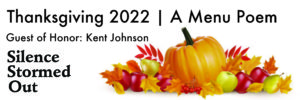
Happy Thanksgiving!
A Menu Poem by Geoffrey Gatza
Silence Stormed Out
Guest of Honor : Kent Johnson 1955 – 2022
IntroductionIntroduction
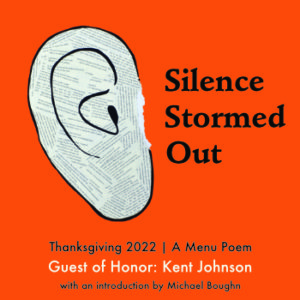
Hello and welcome to the 2022 Thanksgiving Menu-Poem. This is the twentieth incarnation of the Thanksgiving Menu-Poem! This series began in 2002 with a Menu-Poem to honor Charles Bernstein, and since then this series engages Thanksgiving as the basis to celebrate poetry, poets, and the poetry community. Being a trained professional chef, I have blended my love of food and poetry into a book-length work as a feast of words and art to bring everyone a tiny bit closer together.
This project is a conceptual meal served for the thousands of friends I would love to have over to our home on Thanksgiving Day. Since it is unavoidably impossible to even consider doing such a thing in real life, I have designed a menu of foodstuffs that reflect upon the guest of honor as a person, a poet and their poetry. These works directly respond to our surrounding environment and uses everyday experiences as a starting point. Often these are framed instances that would go unnoticed in their original context. With a conceptual approach, this menu-poem tries to increase the dynamic between audience and author by objectifying emotions and investigating the duality that develops through different interpretations.
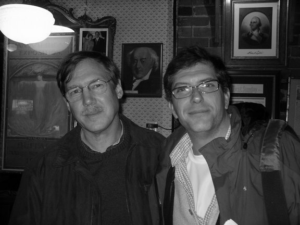 This year our guest of honor is Kent Johnson who died in October. To honor our dear friend, we asked Michael Boughn to introduce Kent this evening. Michael, along with his co-conspirator, Kent Johnson, edited the online turmoil called Dispatches from the Poetry Wars.
This year our guest of honor is Kent Johnson who died in October. To honor our dear friend, we asked Michael Boughn to introduce Kent this evening. Michael, along with his co-conspirator, Kent Johnson, edited the online turmoil called Dispatches from the Poetry Wars.
I hope you enjoy this meal, the menu and the poem. And do send all of your love to Kent! Have a Happy Thanksgiving!
Rockets, Geoffrey
An Introduction by Michael Boughn
Being asked to introduce Kent Johnson is a little bit like being asked to introduce the Sphinx. Or the Grand Canyon. His presence in the contemporary worlds of poetry, especially in North and South America, is enormous and has been for a long time. It’s hard to know where to begin. Partly that’s because he’s a oner. His sharp eye for hypocrisy and self-delusion, his delightfully subversive imagination, and his deceptively easy way with words make him unique in the current scene. His lonely satirical voice stands out in the wilderness of careerist USAmerican poetry. He also happens to be one of the finest poets of his generation. This latter fact is sometimes lost in all the antagonistic noise his work incites. Yes, he likes to poke at the guy behind the curtain, to even pull back the curtain, which is known to cause howls of phony protest and a chorus of predictable slanders from those who stand exposed. But he is also the master of multiple forms of poetry, many from other cultures, many obscure and rare in a poetry market based on endlessly reproducing monotony. Nor is he above inventing form when he needs to. And his ear is immaculate. I’ve never known a poet so closely tuned to the music of his work, so at ease with its working. You never know what Kent is going to do, but when he does it, it’s guaranteed to leave you moved, stunned, provoked, and, most importantly from my perspective, frequently howling with laughter even as you cry in outrage. And that’s rare in today’s world. Kent can do this because he is one of the most generous people I have ever met, and his generosity extends to every aspect of his life. Those who have had the honour (OK, and sometimes, I admit, the tribulation) of working with him have seen it in the way he constantly reaches out to help poets young and old. But even his beloved poetry can’t contain the generosity of his spirit, and so he delivers food to the elderly through Meals on Wheels in the evenings, and when his church decided to help post-hurricane Puerto Rico, Kent signed up, hauling bags of cement and sand and helping the people to rebuild their wounded lives. Because that’s the kind of guy he is. Poetry for Kent is far more than words on a page. It is a commitment to a further world, a better world, a world he dedicated his life to help build. He’s what we used to call the Real Deal.
Michael Boughn spent much of his adult life in a complicated relationship with borders which has led to a lack of determinable national identity and a general sense of disordered devotion to a common mind. He has published numerous books of poetry in both Canada and the US, including Hermetic Divagations–After HD and City–A Poem from the End of the World. Cosmographia—A Post-Lucretian Faux Micro-Epic (Book Thug, 2011) was short-listed for the Governor General’s Award for Poetry, leading one Canadian commentator in the Globe and Mail to describe him as “an obscure, veteran poet with a history of being overlooked by the mainstream.” A collection of essays on poetry, Measure’s Measures — Literary Assays, is forthcoming from Station Hill Press (Barrytown, NY) in 2022. He is the co-editor with Victor Coleman of Robert Duncan’s The H.D. Book. From 2014 to 2018 he edited the online turmoil called Dispatches from the Poetry Wars with co-conspirator, Kent Johnson, which is now archived in the Contemporary Literature Collection at Simon Fraser University Library’s Special Collections.
Thanksgiving Menu-Poem
Silence Stormed Out
Guest of Honor : Kent Johnson
Color
Layers of Thinly Pounded Yellowfin Tuna,
Campari Granita, Lime Infused Olive Oil
Pierre Gimonnet & Fils, Blanc de Blancs 1er Cru, Extra Brut, Cuis NV
Line
Pan Roasted Dover Sole, Onion Gratin
with Spiraled Apple and Black Truffle Emulsion
Vernaccia di San Gimignano, Montenidoli, Fiore, Tuscany, Italy 2020
36 Synonyms for Life, Living, and Death
Shape
Sea Scallops “Plumeria”, Sabayon of Pearl Tapioca,
Pickled Tiny Sweet Peppers, Baby Root Vegetables
Bollinger, La Grande Année, Aÿ, France 2014
Form
Goose Roasted with Caraway, Tamarind Jus, Green Lentils, Turnips & Crispy Pear
Pear Cider, Eric Bordelet, Poirè Granit, Normandy, France 2021
Texture
Honey Port Roasted Fig, Bûche de Noël, Madeleines,
Beerenauslese, Alois Kracher, Neusiedlersee, Austria 2018
Visual Eyes
[collage poem series]
Thanksgiving Menu 2022 by BlazeVOX [books] on Scribd
The Menu, Wines, Poem
The menu
The structure of the menu takes the form of the basic elements of art (color, line, shape, form, and texture). Starting with Color to convey atmosphere and mood, then we look at Line to convey movement and mood. The next course is Shape where each item bounces between geometric and natural shapes, then we move to into the wonder of how shapes become Form. And we end on different types of food materials and techniques used to achieve varying textures. The autumnal season brings variety of senses to mind, and with it a colorful, artful designs. The meal captures these through aroma, temperature variations, mixed textures and flavor combinations that greet you with a serene, elegant scenery of nature. This thanksgiving feast is complemented by seasonally selected autumnal foodstuffs that not only tastes well-balanced but are also a pleasant to think about.
The wines and beverages
We start the meal off with a Premier Cru champagne from Pierre Gimonnet & Fils. The Chardonnay grapes offer all the flavors you want from a bubbles with a little floral backend that will highlight the Yellow Fin Tuna. Next up is a compelling white wine from Tuscany. The Vernaccia is a white variety, produced in the region of San Gimignano. This is a great white wine with a fragrant nose with floral aroma, tastes of lime, lemon, pear, apricot, and pepper on the palate. For the Shape course we chose another champagne, a Bollinger, La Grande Année, Aÿ, France 2014. This is a powerful, balanced and elegant champagne with citrus and apple notes, lemon pear as well. It is very enjoyable. For the main course we are serving Goose. And to match that hearty water-fowl richness we choose a Pear Cider from Eric Bordelet. This Normandy cider is very exciting, with complex and electric deep pear and apple flavors and a tartness that tingles on the tongue. And we finish the meal with an Austrian dessert wine from 2018. Beerenauslese, literally means, “selection of berries” from the German is a term for a late harvest wine with noble rot. It is sweet with a fresh peach, honey, and strong botrytis notes. Orange zest and caramel and honey in mouth, not too heavy and very smooth.
The poetry
This series consists of five sets of poetry, which include two sets of List Poems, two sets of Collage poems, and one longer sequence of text art, entitled, Collaging Things.
The two List poems address this season of change as an exploration of the cycles between thoughts of memory and the thoughts of experience, these poems delve into the tradition of remembrance as art, as an act of meditation.
The middle piece, Collaging Things is a text art poem made in a graphic design program. The text come from the novella, Things by Alice Duer Miller. The text was broken apart in Microsoft Excel, randomized and then set into lines of poetry. The characters of the novel were replaced by characters from the fairy story, Little Red Riding Hood.
The two Collage poems take different forms. The first, Within Reach, is a constructed poem rather than invented. It is a disjointed arrangement with serendipitous results. The piece itself is constructed with watercolor paper, paints, and various media. The last piece, Visual Eyes, is a collage poem series consisting of ten pieces. Each is 16 x 20 inches. The ten art poems are constructed with ink, markers, and watercolors on mounted watercolor paper. They question the conditions of appearance of an image in the context of contemporary visual culture in which images, representations and ideas normally function. By experimenting with handwriting processes, these drawings generates multiple meanings. Associations and meanings collide. Space becomes time and language becomes image.
These art pieces focus on the instability of communication which is used to visualize reality, the attempt of dialogue, the dissonance between form and content and the dysfunctions of language. In short, the lack of clear references are key elements in the work. By exploring the concept of collage in a reflective way, these pieces investigate the dynamics of language, including the manipulation of its effects and the limits of spectacle based on our assumptions of what the imagery and texts means to us. Rather than presenting a factual reality, an illusion is fabricated to conjure the realms of our imagination.
Kent Johnson
Biography: [from Wikipedia]
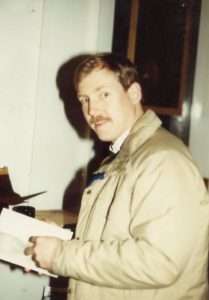 Since the late 1990s, Johnson has widely been thought to be the author of the Araki Yasusada writings, which a reviewer for the Nation magazine, in 1998, called “the most controversial work of poetry since Allen Ginsberg’s Howl.”[1] Johnson, however, has never officially claimed authorship of the material, presenting himself only as “executor” of an archive supposedly composed by a writer, or writers, whose choice has been to maintain a principled anonymity in relation to the work. In recent years, the Yasusada discussion has moved from the realm of literary scandal and gossip into considerations of more scholarly kind, and a substantial number of academic articles have by now engaged the topic, pro and con. In 2011, a book of critical studies, Scubadivers and Chrysanthemums: Essays on the Poetry of Araki Yasusada, was published in England, to which Johnson was one of eighteen contributors.[2]
Since the late 1990s, Johnson has widely been thought to be the author of the Araki Yasusada writings, which a reviewer for the Nation magazine, in 1998, called “the most controversial work of poetry since Allen Ginsberg’s Howl.”[1] Johnson, however, has never officially claimed authorship of the material, presenting himself only as “executor” of an archive supposedly composed by a writer, or writers, whose choice has been to maintain a principled anonymity in relation to the work. In recent years, the Yasusada discussion has moved from the realm of literary scandal and gossip into considerations of more scholarly kind, and a substantial number of academic articles have by now engaged the topic, pro and con. In 2011, a book of critical studies, Scubadivers and Chrysanthemums: Essays on the Poetry of Araki Yasusada, was published in England, to which Johnson was one of eighteen contributors.[2]
Lyric Poetry after Auschwitz: Eleven Submissions to the War (its contents later included into a larger collection, Homage to the Last Avant-Garde, 2009) was published in 2005. As the first book of poetry in the United States to respond to the wars in Afghanistan and Iraq, it was the subject of numerous reviews and blog commentaries, a good deal of the latter hostile. The title poem of the collection, “Lyric Poetry after Auschwitz, or: Get the Hood Back On,” angrily confronts the torture committed at Abu Ghraib and elsewhere, though it does so in a manner quite non-conventional for “anti-war” poetry: The poem proceeds in a series of stanzas set in the voices of American military prison guards, who calmly chat with Iraqi prisoners and sociably describe their quite normal backgrounds at home, before graphically informing the prisoners of the tortures to which they will be subjected. The poem, however, concludes unexpectedly when the voice of a generic U. S. poet joins the chorus of torturers, and in good-natured tone tells his captive to stop pleading and just accept the horror of his fate, because there is, after all, nothing that poetry can do to help him.
More recently, Johnson became the focus of controversy, including threatened legal action, when he published a book that proposed, by means of an elaborate, forensically detailed hypothesis (supplemented in the book by a quasi-detective novella), that the poet Kenneth Koch may have been the hidden author of “A True Account of Talking to the Sun at Fire Island,” one of Frank O’Hara’s canonical poems, composing it shortly after O’Hara’s death, and then placing it under his late friend’s name in a sui generis act of comradeship and mourning.[3] First published in a limited edition in 2011, an expanded, second edition of this book, titled A Question Mark above the Sun: Documents on the Mystery Surrounding a Famous Poem “by” Frank O’Hara, was published in 2012 and named a “Book of the Year” by the Times Literary Supplement.
Johnson lived most of his childhood and adolescence in Montevideo, Uruguay, returning to work there in the mid-1970s. In the early 1980s, on two extended visits, he worked with the Sandinista Revolution as a literacy and Adult Education teaching volunteer in rural zones of Nicaragua. Since 1991, he has taught English and Spanish at Highland Community College in Freeport, Illinois. In 2004, he was named State Teacher of the Year by the Illinois Community College Board of Trustees.[4] He has received a Pushcart Book of the Month Award, an Ohio Board of Regents Grant for research in the U.S.S.R., an Illinois Arts Council Poetry Prize, a National Endowment for the Arts Literature Fellowship, a PEN Translation Grant, a Finalist nomination for the PEN Award for Poetry in Translation, a travel grant from the University of Chile, and a Visiting Writer Grant from the U.S. Embassy in Uruguay.
Selected works
Poetry and Chapbooks
- Waves of Drifting Snow.Ox Head Press, 1986.
- Dear Lacan: An Analysis in Correspondence.(with Jaques Debrot), CCCP Translation Series (UK), 2003.
- The Miseries of Poetry: Traductions from the Greek.CCCP Translation Series (UK), 2003.
- The Miseries of Poetry: Traductions from the Greek.Skanky Possum Press, 2004.
- Epigramititis: 118 Living American Poets.BlazeVOX Books, 2005.
- Lyric Poetry After Auschwitz: Eleven Submissions to the War.Effing Press, 2005.
- I Once Met.Longhouse Books, 2007.
- Homage to the Last Avant-Garde.Shearsman Books (UK), 2008.
- 5 Works from the Rejection Group.Habenicht Press, 2012.
- [Untitled]. Both Both Series, 2012.
- Homage to Villon. Beard of Bees, 2014.
- Works and Days of the fénéon collective, Delete Press (e-book), 2014.
- Prize List.Delete Press (e-book), 2015.
- Homage to the Pseudo Avant-Garde(Dispatches Editions, 2017).
- Because of Poetry, I Have a Really Big House(Shearsman Books, 2020).
Edited Collections and Translations
- A Nation of Poets: Writings from the Poetry Workshops of Nicaragua(translation, introduction and interview with Father Ernesto Cardenal). West End Press, 1985.
- Have You Seen a Red Curtain in my Weary Chamber: Poems, Stories and Essays by Tomás Borge Martínez(translation, with Russell Bartley and Sylvia Yoneda). Curbstone Press, 1989.
- Beneath a Single Moon: Buddhism in Contemporary American Poetry(editor, with Craig Paulenich). Shambhala, 1990.
- Third Wave: The New Russian Poetry(editor, with Stephen Ashby). University of Michigan Press, 1992.
- Joyous Young Pines(editor, Araki Yasusada chapbook). Juniper Press, 1995.
- Doubled Flowering: From the Notebooks of Araki Yasusada(editor). Roof Books, 1997.
- Immanent Visitor: Selected Poems of Jaime Saenz(translation, with Forrest Gander). University of California Press, 2002
- Also, with My Throat, I Shall Swallow Ten Thousand Swords: Letters of Araki Yasusada(editor). Combo Books, 2005.
- The Night,Jamie Saenz (translation with Forrest Gander). Princeton University Press, 2007.
- Hotel Lautreamont: Contemporary Poetry from Uruguay(editor, with Roberto Echavarren). Shearsman Books (UK), 2012.
- The Herald of Madrid: César Vallejo’s Lost Interview(annotated translation). Ugly Duckling Presse, 2014.
- Resist Much, Obey Little: Poems to the Resistance(coordinated and introduced with Michael Boughn, Dispatches Editions, 2017).
- El Misterio Nadal: A Lost and Rescued Book(Spuyten Duyvil, 2018).
- Materia Prima: Selected Poems of Amanda Berenguer(co-edited with Kristin Dykstra, Ugly Duckling Presse, 2019).
Prose and Critical Fiction
- Poetic Architecture: Eleven Quizzes.BlazeVox Books, 2007.
- “DAY.” BlazeVOX/The Figures, 2010.
- Doggerel for the Masses.BlazeVox Books, 2012.
- A Question Mark above the Sun: Documents on the Mystery Surrounding a Famous Poem “by” Frank O’Hara.Starcherone Books, 2012 (previously published by Punch Press, 2011).
- I Once Met: A Partial Memoir of the Poetry Field.Longhouse Books (revised and expanded edition), 2015.
Selected Interviews
- “Argotist Magazine interview, conducted by Jeffrey Side”. The Argotist Online.
- “Coyote Magazine interview, conducted by Rodrigo Lopes Garcia”. Coyote Magazine.
- “Reconfigurations Journal interview, conducted by Mario Hibert”. Reconfigurations.
- “Big Bridge interview, conducted by Pedja Kojovic”. Big Bridge.
- Rain Taxi Interview, conducted by Michael Boughn
Selected Essays
- “Avant, Post-Avant, and Beyond”. Boston Comment.
- “Notes on Notes on Translation”. Jacket Magazine.
- “Imitation, Traduction, Fiction, Response”. Jacket Magazine.
- “Marjorie Perloff, Avant-Garde Poetics, and the Princeton Encyclopedia of Poetry and Poetics.”(PDF). Chicago Review.
- “Poetic Economies of Scale” The Claudius App
- “Notes on Safe Conceptualisms”. Lana Turner Journal.
- “No Avant-Garde: Notes Toward a Left Front of the Arts”. Lana Turner Journal.
- “Competence, Linguistics, Politics & Post-Avant Matters”. Absent Magazine.
- “Why Communism Looks Out of Their Eyes”
Interesting links
- Author Bio
- “Some Darker Bouquets”: Thirty two poets and critics respond to Johnson’s comments on “Negative Reviews”
- John Beer on Homage to the Last Avant-Gardein the Chicago Review at the Wayback Machine (archived September 15, 2012)
- Johnson talk at The Walker Center
- Jeffrey Beam on Homage to the Last Avant-Gardein Oyster Boy Review
- Michael Theune on various works by Johnson
- Tony Tost on The Miseries of Poetry in Jacket Magazine
- David Hadbawnik on “Kent Johnson’s Hybrid Critique” in Montevidayo
- Jenny Hendrix on A Question Mark Above the Sunin The New Republic
- Jeremy Noel-Tod, review of I Once Metin Chicago Review

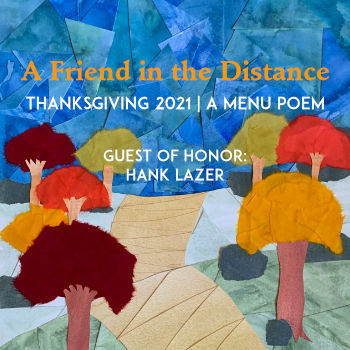

Comments (0)